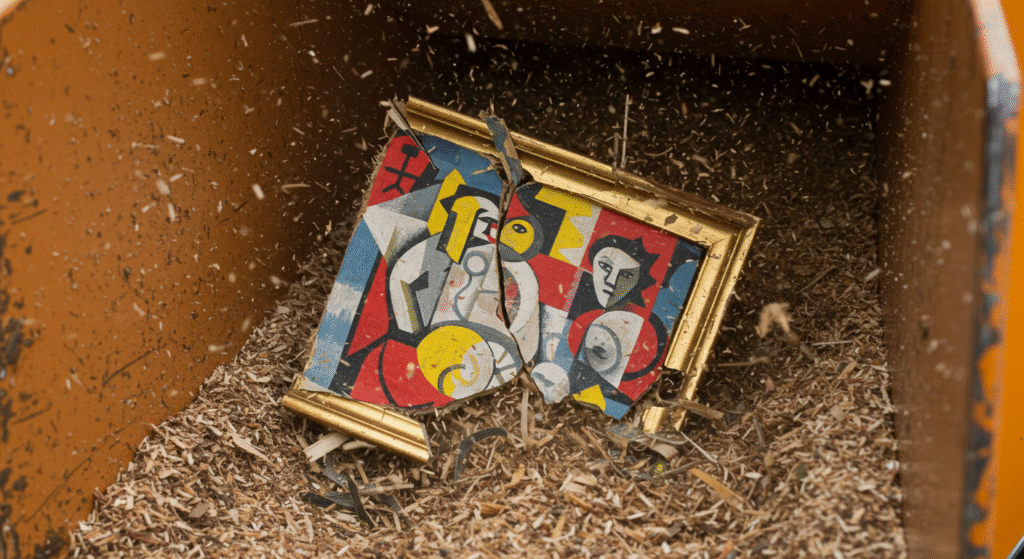Inventory controls – what is in your collection, where it is located, and who is responsible for maintaining that information – is perhaps the most important aspect of collections management. According to the AAM Code of Ethics for Museums, U.S. museums are organized as public trusts with the responsibility to ensure the collections in their custody are “lawfully held, protected, secure, unencumbered, cared for and preserved.”
Artworks or other cultural objects are especially vulnerable when being moved, whether for conservation or a loan to another institution. Without strict internal controls and management – including where collection items are located at any given time – museums run the risk of damage or loss.
A Léger Goes Missing
Fernand Léger was considered an early pioneer of cubism. His simplified treatment of subject matter was a forerunner to pop-art, and his oil on canvas, La femme et l’enfant (translated as Woman and Child), was a key work in the series of female figure paintings that Léger created in early 1921.
The painting highlighted the fundamental human relationship of a woman caring for her offspring. At the time, this was an important concept in France, since representations of the child – especially a male child – were considered key to future national prosperity as the country had suffered 1.4 million military casualties during the Great War.

Back in 1954, La femme et l’enfant was gifted to the Davis Museum & Cultural Center at Wellesley College, a private liberal arts women’s college located exactly 13.1 miles from the finish line of the Boston Marathon (I know this from personal experience).
Fast forward to 2006, when La femme et l’enfant was one of 32 pieces the Davis loaned to the Oklahoma City Museum of Art for the exhibition entitled Monet to de Kooning. At the close of the exhibition in April 2007, the painting returned to the Davis Museum where, inexplicably, it sat in a shipping crate for months. Either strong inventory controls for returning loans were not in place or not followed.
In November of that year, museum staff noticed the painting was missing, and after conducting a thorough search, contacted the Boston FBI for assistance. As the field office’s Art Crime Team representative, I got the call. I drove out to the Davis and met with the museum staff, who assured me that the piece was nowhere on the museum’s campus; it appeared to have been stolen.
In order for the case to be worked by the FBI, I first had to demonstrate that the painting satisfied the elements of the National Stolen Property Act (Title 18, US Code, § 2314, in case you’re taking notes), in that it crossed state lines or international boundaries and possessed a value of at least $5,000. With an insured value of $3 million, La femme et l’enfant certainly exceeded the monetary threshold, and while I had no information that the missing Léger had crossed state lines after it had been stolen (if it had, in fact, been stolen), I was authorized to investigate the matter based on a presumption that it had. And with that, I opened a new art theft matter and began a logical investigation in an effort to recover La femme et l’enfant.
Painting Lost and Found (?)
The initial investigation focused on security protocols at the museum, especially the guards, many of whom were Wellesley College students. Since more than 80% of all art pilfered from museums involves a staff member or someone in a position of trust, my investigation naturally focused on the employees, yet after conducting a number of interviews and polygraph examinations, there was no one employee who looked like a viable suspect.
Through my investigation, I determined that La femme et l’enfant had been properly crated in Oklahoma and safely delivered to the Davis Museum back in April, yet no collections manager inventoried the painting upon its return. In fact, after interviewing every employee who would have had the authority to handle the piece, it turns out that no one had removed the painting from its shipping crate. Again, whether inventory controls were not present or simply not followed is unknown.
The case is solved,” I told them. “It’s still in the crate.”
So where’s the crate?
It turns out that sometime between April and November, the crate – along with the $3 million Léger inside – had been sent to a recycling facility and shredded into wood chips.

The Davis Museum was able to keep this gaffe a secret until the following August when the story broke in The Boston Globe [G. Edgers, August 29, 2008]. The museum director resigned two weeks later, and Wellesley officials declined to comment when asked if his departure had anything to do with “the recent, shocking revelation that the museum had lost its 1921 Fernand Léger painting ‘Woman and Child’” [The New England Journal of Aesthetic Research, Sept. 11, 2008].
Ultimately, Travelers Insurance paid out a $3 million claim to the Davis for the missing Leger, and in a rather optimistic move, offered a $100,000 reward for its recovery. I assume it was a reward that could only be claimed by someone who’s really, really good at jigsaw puzzles.
In addition to bad press, the failure to safeguard a collection can have long-term repercussions for a museum. In the case of the Léger, a senior lecturer in the college’s art department and adjunct curator demanded the return of three works which she had donated to the Davis years earlier. According to the donor:
“It’s a bad place to give any art objects to, and I want all of them back.”
That’s not a good quote for any museum curator.
External Audits of Inventory Controls Can Prevent Losses
For its part, the Davis Museum learned from the loss. In the aftermath, they hired an external audit firm with experience in museum operations to conduct a review of the existing inventory controls and management and assess the risk. As a result, they adjusted their policies and procedures in an effort to enhance controls regarding museum operations; however, all museums would be well-served to assess their policies and procedures before paintings go missing, a belief seconded by their insurance carriers.
And that’s where Argus comes in. With decades of real-world experience helping private collectors, museums, and other cultural institutions safeguard valuable artwork and precious cultural property, Argus Cultural Property Consultants can conduct a thorough assessment of your collection protocols to prevent loss, theft…or the wood chipper.
